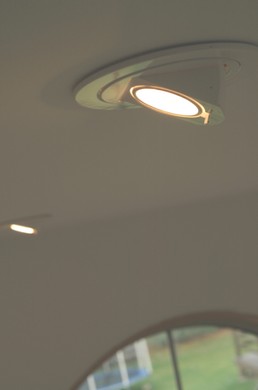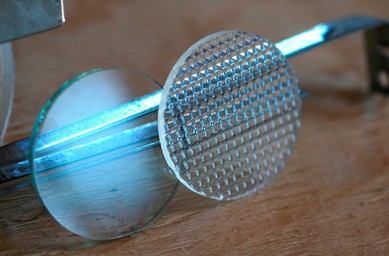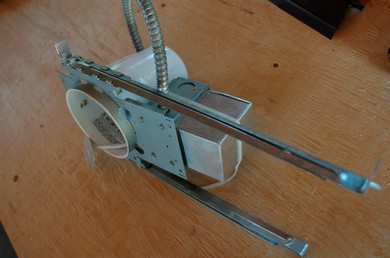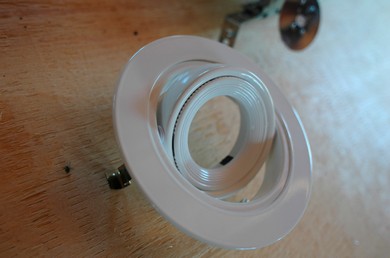 Recessed lighting combines gorgeous aesthetics and practical features in a way that no other lighting system can match. But to enjoy these benefits without surprises, you need to understand some pretty obscure technical details as well as an astonishingly wide range of bulb, fixture and switch choices. Success with recessed lighting demands more thinking than other fixture systems, but the results are worth it.
Recessed lighting combines gorgeous aesthetics and practical features in a way that no other lighting system can match. But to enjoy these benefits without surprises, you need to understand some pretty obscure technical details as well as an astonishingly wide range of bulb, fixture and switch choices. Success with recessed lighting demands more thinking than other fixture systems, but the results are worth it.
Recessed lights (also called ‘pot lights’) have come along way from the large, plain, ceiling-mounted floodlights that appeared in the 1960s and 70s. And the biggest difference between now and then is choice. There’s a lot, and the first step towards working through all the options is identifying what you want to accomplish.
Are you after ambient lighting in an attic loft that’s not tall enough to handle hanging fixtures? Or how about spotlighting of art or collectibles? Perhaps you need to angle some light along a sloped ceiling of a second-story bedroom? All of these challenges and more can be easily met with the right kind of recessed fixtures and bulbs. The trick is to choose well.
When it comes to recessed lights, most people think of aesthetics first. The part of a recessed light that you see is called the ‘trim ring’, and while choosing this component is important, hold on for a minute. Your first priority must be assessing your intended ceiling situation.
Right Light for the Job
- The simplest way to come to a decision about recessed lighting is to ask yourself two questions. Low-voltage or high-voltage? Insulated or non-insulated ceiling space?
 If your room needs a wide beam of light for general illumination, then consider a fixture that uses a 120-volt, flood-style light bulb. This is the so-called high voltage option and is also the simplest. The hardware is inexpensive, dimmer switches are cheap and replacement bulbs have the usual screw-type Edison base of the sort found on light bulbs everywhere.
If your room needs a wide beam of light for general illumination, then consider a fixture that uses a 120-volt, flood-style light bulb. This is the so-called high voltage option and is also the simplest. The hardware is inexpensive, dimmer switches are cheap and replacement bulbs have the usual screw-type Edison base of the sort found on light bulbs everywhere.- On the downside, high-voltage recessed fixtures are often large and visually obvious. That’s why designers created small, low-voltage light systems. The most popular of these use what’s called an MR16 bulb. With a face diameter of just 2 inches, these small, 12-volt bulbs are surprisingly bright and versatile. You’ll find them at most hardware stores, too.
- Low-voltage fixtures are complicated by the need for a transformer to step down 120-volt household current, but what you get in return is greater visual options, especially in the MR16 category. For specific details, see Filtered Light.
- Perhaps the most important technical issue you need to deal with is the nature of the space above your
 recessed lights. Is it a heated, fully indoor space, such as an insulation-free joist cavity between two levels in a house? In this case, any kind of recessed fixture will do just fine, as long as it’s installed according to manufacturer’s directions, with nothing touching the fixture. But if your recessed fixtures are to be surrounded by insulation — in a cold attic for instance — then you absolutely must use a fixture that bears the ‘IC’ designation. These letters stand for the words ‘in contact’. This means they’re safe even when completely shrouded in insulation, though there’s something else important about IC fixtures, too.
recessed lights. Is it a heated, fully indoor space, such as an insulation-free joist cavity between two levels in a house? In this case, any kind of recessed fixture will do just fine, as long as it’s installed according to manufacturer’s directions, with nothing touching the fixture. But if your recessed fixtures are to be surrounded by insulation — in a cold attic for instance — then you absolutely must use a fixture that bears the ‘IC’ designation. These letters stand for the words ‘in contact’. This means they’re safe even when completely shrouded in insulation, though there’s something else important about IC fixtures, too. - Besides being rated for safe insulation contact, IC fixtures are also designed to prevent warm, moist indoor air from leaking up through the fixture and condensing in the attic space during winter. IC fixtures are sealed, and if it weren’t for this key feature, frost and water would develop above them during cold weather, damaging the fixture and your home.
- Your next decision is about trim rings. These are the parts of a recessed fixture that you see, and the choices here are easy. What do you like? Some hold the bulbs fixed, while others allow the bulb to be aimed at an angle. Not all trim rings fit onto all fixtures, so ask before you buy.
- There are thousands of recessed lights on the market, and all of them offer a sleek elegance that you can’t quite get in any other way. Choose the right one for your space, then enjoy what only modern lighting can do for your home.
Sidebar: Dimming Low-Voltage Lights
- Installing a dimmer control for a standard, 120-volt incandescent light bulb is a cheap and easy proposition. Just buy a $10 dimmer switch and wire it into the switch box. That’s it. But when it comes to low-voltage fixtures
 involving the popular MR16 bulbs, you need something more. Regular dimmers won’t work well here. They can cause buzzing sounds to come from internal transformers and also lead to overheating. The fact is, you need different dimmer controls for low-voltage applications, and this fact has some bearing on the recessed light fixtures you choose.
involving the popular MR16 bulbs, you need something more. Regular dimmers won’t work well here. They can cause buzzing sounds to come from internal transformers and also lead to overheating. The fact is, you need different dimmer controls for low-voltage applications, and this fact has some bearing on the recessed light fixtures you choose. - There are two types of transformers that reduce 120-volt household current to the 12 volts used by low voltage bulbs: magnetic or electronic. Most low-voltage systems use magnetic transformers, and the dimmer required to control them costs about $40. Not cheap, but not outrageous. These dimmers are designed to control ‘inductive’loads and are commonly available in hardware stores.
- Other types of low-voltage fixtures have electronic transformers and most require a completely different and more expensive type of dimmer control. Expect to pay more than $100 for the kind of electronic dimmer hardware required here.
Sidebar: Filtered Light
One of the best things about the MR-16 low-voltage bulb is the wide array of filters made to fit them. You’ll find lenses to diffuse the light, change the colour of the beam, or soften shadow lines. Couple this with the MR-16’s small and unobtrusive size, and it’s no wonder that designers everywhere love this bulb and the compact fixtures that go with them.